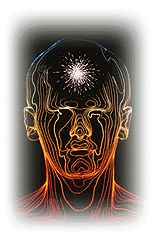Substituting other plants for the ayahuasca vine and companion plants — chacruna, sameruca, chagroponga — is part of a quest for what are called ayahuasca analogues — duplications of the ayahuasca drink “compounded with the correct percentages of DMT and beta-carbolines,” as chemist Alexander Shulgin puts it, but using materials more readily available in North America. One of the most commonly used alternative sources of β-carbolines is the plant Peganum harmala, also called Syrian rue, which grows wild in the western states, and is available in South Asian and Middle Eastern groceries under the name esfand or harmal. Potential sources of DMT include a wide variety of plants in the genera Acacia, Desmanthus, Phalaris, and Mimosa. There are a number of neologisms for these analogues generally, such as pharmahuasca, anahuasca, and gaiahuasca, and for specific combinations, such as mimosahuasca and acaciahuasca.
 |
Indeed, DMT is widely distributed in the natural world. DMT, as well as its even more potent cousin, 5-methoxy-N,N-dimethyltryptamine (5-MeO-DMT), is found not only in mimosa (Mimosa hostilis), wattle (Acacia spp.), giant river reed (Arundo donax), bundle flower (Desmanthus illinoensis), and canary grass (Phalaris tuberosa), but also in the venom of the Colorado River toad (Bufo alvarius), and, endogenously, in human beings.
No one seems quite sure what to make of this last fact. DMT has been identified in human blood, urine, brain tissue, and cerebrospinal fluid; it apparently easily passes into the brain through the blood-brain barrier. No one knows where this DMT in the human body comes from. In fact, the human body is full of tryptamines, all chemically related to the dietary amino acid tryptophan, including melatonin and the ubiquitous seratonin. Still, the presence of DMT is surprising — as surprising as if the human body endogenously produced, say, psilocybin or bufotenin, also natural tryptamines.
Psychopharmacologist Rick Strassman thinks the source of this DMT may be the pineal gland, which is, coincidentally, the organ Rene Descartes considered the seat of the soul and the place where all our thoughts are formed. The pineal produces serotonin, melatonin, and β-carbolines, which, as we have discussed, are potent MAO-A inhibitors.
 |
In 1988, psychopharmacologist Jayce Callaway — now well-known as a member of the Hoasca Project studying the use of ayahuasca by the União do Vegetal in Brazil — proposed that, at night, serotonin becomes converted into DMT by the pineal gland and plays a central role in activating dreams. Similarly, Strassman, himself a practitioner of Zen meditation, hypothesized that “when DMT levels get too high for normal function … we start undergoing unusual experiences” — what he called states of “mystical/spiritual consciousness,” such as during birth, just before death, during near-death experiences, and in deep meditation. He also thought that excess DMT might be a factor in some forms of hallucinatory psychosis.
As far as I know, these ideas remain speculative, and unsupported by empirical research. For example, comparison of urine in schizophrenics and non-schizophrenic controls has failed to show any systematic differences in DMT levels. I know of no research comparing, say, blood DMT levels in normal controls and subjects immediately postpartum or postmortem, or in normal controls and persons in deep meditative states, or in dreaming and nondreaming sleepers, all of which ought to be relatively simple to do.
 |
The thought has been that the trace levels of DMT and other endogenous psychoactive tryptamines in the human body are just too low to have much effect, and are insignificant metabolic byproducts. However, scientists are now investigating what is called a G-protein-coupled, human trace amine receptor, where even trace amounts of DMT elicit a surprisingly strong response. But, with apparent paradox, trace amounts of amines at this receptor, including amphetamines and dimethyltryptamine, may produce mental states of calm and relaxation, which may account for the calming effect of amphetamines such as Ritalin at low doses.
In other words, our ignorance of the source and function — if any — of endogenous DMT remains virtually complete.

- Previous Post: Jungle and Rainforest
- Next Post: Strassman Redux
- More Articles Related to: Ayahuasca, Research Studies


